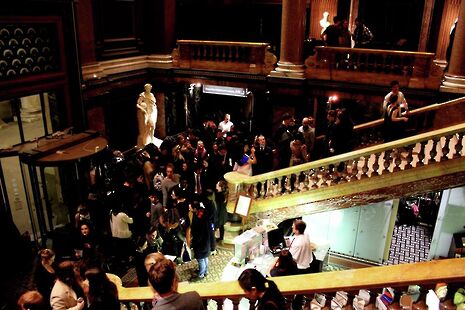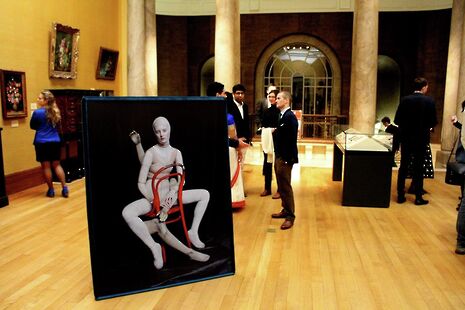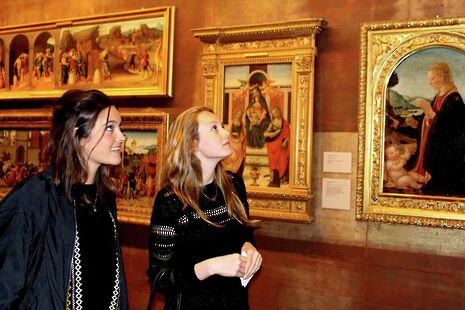Love Art After Dark: A Personal Perspective
Miranda Gabbott takes us behind the scenes of this magical night at the Fitzwilliam Museum

As a History of Art fresher, I had heard rumours about the annual event when the Fitzwilliam Museum opens its doors to students after hours. I knew that Love Art After Dark was supposed to be ‘our’ special night, when people from across the university come together to acknowledge the extraordinary gift we have in the form of the collection at the Fitzwilliam, but when I signed up to steward I had no idea of exactly how this was going to be pulled off. It is difficult to balance a night of drinking and music in a gallery with constant awareness that it is being done in celebration of centuries of world-class art. My college mum was right when she told me, “You’ll never see the Fitzwilliam like this any other time!”
There was a marked sense of anticipation at the member’s champagne reception. The glamour of hanging out in black tie in an art gallery obviously contributed to this, but the setting was not as serene as it sounds. The museum was already humming; bands and bars were being set up and security guards were anxiously waving walkie-talkies. A latecomer told me that there was already a queue forming outside.
As it neared opening time, I was hurried to my station at the main entrance. A member of the museum staff in a red cardigan frantically handed me a wad of programmes and some drinks tokens. I asked her if perhaps it would be easier if I handed out one thing and she the other, to which she shook her head “when they start coming in, there will not be time – just you wait and see.” She looked as if she was going into battle.

As soon as half six struck, the chaos ensued as people struggled through the revolving doors and into the museum. The stream of people was relentless – my guide in the red cardigan was right! I could barely stop the flow of students to give them a free drink token. At some point during the frenetic first couple of hours, the lady in the red cardigan had made several trips to supervise the wine bar and began to slur. I would have done the same in her position.
A thousand programmes had been printed, but the unprecedented number of visitors meant that these quickly ran out. There was a huge range of activities densely packed into the two hour time slot, from puppet-making workshops to talks on pieces of art to ever-popular life-drawing. The event’s great strength was the opportunities it offered to engage with various forms of art in an interactive way, in addition to providing the chance to look at pieces in an informal atmosphere.

The King’s men performance was my personal highlight. The rich harmonies of the group were perfectly suited to the opulent surroundings of gallery three, the main portrait room. I looked around at the Victorian faces staring sternly from the walls as the whole room stood silent in its black tie for the a-cappella performance; it was magical.
Running around in my little blue sash searching for more programmes, I had the great feeling of being part of something important. The museum was truly alive, almost vibrating. By day, art galleries can seem like sombre and serious places. It was incredibly freeing to watch students dressed in their finery – or in their jeans, or wacky jumpers – feeling comfortable around art and enjoying it, without feeling like they have to decode all of its mysteries in order to be worthy of its presence.
The incredible thing was that amongst the music and wine and frivolity, the Fitz was still functioning as a museum. As I walked around, I noticed people having private moments with the paintings; a girl was sketching in a corner by the stairs and the Impressionist gallery was as popular as ever.
Love Art After Dark was chaotic, musical, and a thoroughly good party, without ever losing sight of its cultural aim. Apart from being great fun, this event makes art accessible to anyone at the university who is interested, proving that the Fitzwilliam Museum belongs, at least in part, to us students.
 News / Uni Scout and Guide Club affirms trans inclusion 12 December 2025
News / Uni Scout and Guide Club affirms trans inclusion 12 December 2025 News / Pembroke to convert listed office building into accom9 December 2025
News / Pembroke to convert listed office building into accom9 December 2025 Features / Searching for community in queer Cambridge10 December 2025
Features / Searching for community in queer Cambridge10 December 2025 News / Uni redundancy consultation ‘falls short of legal duties’, unions say6 December 2025
News / Uni redundancy consultation ‘falls short of legal duties’, unions say6 December 2025 Science / Did your ex trip on King’s Parade? The science behind the ‘ick’12 December 2025
Science / Did your ex trip on King’s Parade? The science behind the ‘ick’12 December 2025







